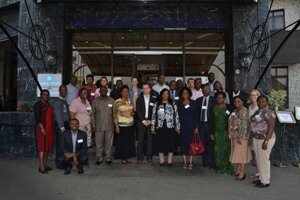By Nina Cromeyer Dieke*
Nigeria is – by far – Africa’s most populous nation. It recently came to light that it is the continent’s biggest economy. It also has the highest burden of NTDs in all of Africa. Therefore, when an opportunity arose in late 2013 to run our GIS training course in Abuja, we were very excited and quickly set about preparing the materials.
Part of my job as communications manager for the Global Atlas of Helminth Infections (GAHI) team at the London School of Hygiene & Tropical Medicine (LSHTM) is the coordination of our five-day course on Modern Tools for NTD Control Programmes. The course is part of GAHI’s capacity building efforts and is aimed at data and programme managers who wish to use geographic information systems (GIS) and mapping to better target their deworming and NTD control plans. The course first took place in Nairobi in May 2013, with 18 participants from 7 African countries. One of the participants was Dr. Obiageli Nebe, the Nigerian Ministry of Health’s National Coordinator for STH and schistosomiasis. We were very pleased to hear, just a few months later, that Dr. Nebe successfully advocated for the course to run in Abuja, a feat that materialised in January 2014 with 21 participants from Nigeria’s FMOH and NGO’s.
After a great visit to Nigeria, the year continued to bode well for GAHI with the re-launch of our website. Still on www.thiswormyworld.org, we now have a brand new design that makes searching for maps, data and our training resources much easier, including the interactive NTD Mapping Tool. We also have a new research section with information about our ongoing work, in addition to mapping. We’re very excited about our new look!
One of the great new additions to the website is maps (and their data) showing water supply and sanitation (WSS) coverage in Sub-Saharan Africa. These are the result of a recent paper in PLOS Medicine, led by GAHI’s Rachel Pullan with Matt Freeman at Emory University, Pete Gething at Oxford, and GAHI’s Simon Brooker. The study found stark in-country inequalities in access to water and sanitation, as well as in practicing open defecation. Demonstrated inequalities for some example countries include a 33.0% to 99.5% range in district-level coverage of improved drinking water in Benin, and a 13.8% to 93.6% range in open defecation in Burkina Faso. We recognise the important links between good WSS access and NTD control, and this type of multidisciplinary research to understand the context of control is increasingly a part of our work.
It’s been a busy year for us so far, but we’re not alone. I’m thrilled by the ever growing momentum around NTD control and elimination, most recently demonstrated at the Uniting to Combat NTDs meeting in Paris. New funding commitments and increasing multi-sector partnerships are getting us closer to 2020 goals, in countries large and small.
Follow GAHI on Twitter,
*Nina Cromeyer Dieke is the communications manager at Global Atlas of Helminth Infections




